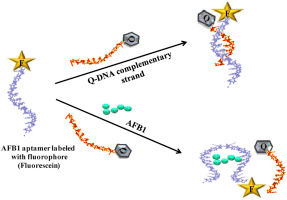TAMRA quenching-based aptasensing platform for aflatoxin B1:Analytical performance comparison of two
- Kotagiri Yugender
- Mar 1, 2020
- 1 min read
In this study, a simple TAMRA (tetramethyl-6-carboxyrhodamine) quenching-based aptasensing platform was designed for the detection of aflatoxin B1 (AFB1). Here, we compared the analytical performance of two aptamer sequences: seqA and seqB. The AFB1 detection was based on the interactions of FAM (carboxyfluorescein)-labeled aptamer with TAMRA-labeled DNA complementary strand in the presence and absence of target analyte. Under optimized experimental conditions, TAMRA-labeled strand quenched the fluorescence response of FAM-labeled aptamer due to the noncovalent interaction between the two DNA strands. The binding of AFB1 induced the complex formation and weakened the interaction between FAM-labeled aptamer and TAMRA-labeled complementary strand, resulting in the fluorescence recovery. By using this principle concept, an assay was constructed for the detection of AFB1. The method exhibited good sensitivity, good selectivity with a limit of detection of 0.2 ng ml−1, and a wide linear range from 0.25 to 32 ng ml−1. For real sample application, the aptasensors were tested in beer and wine samples, with good recovery rates obtained for AFB1 detection






Comments